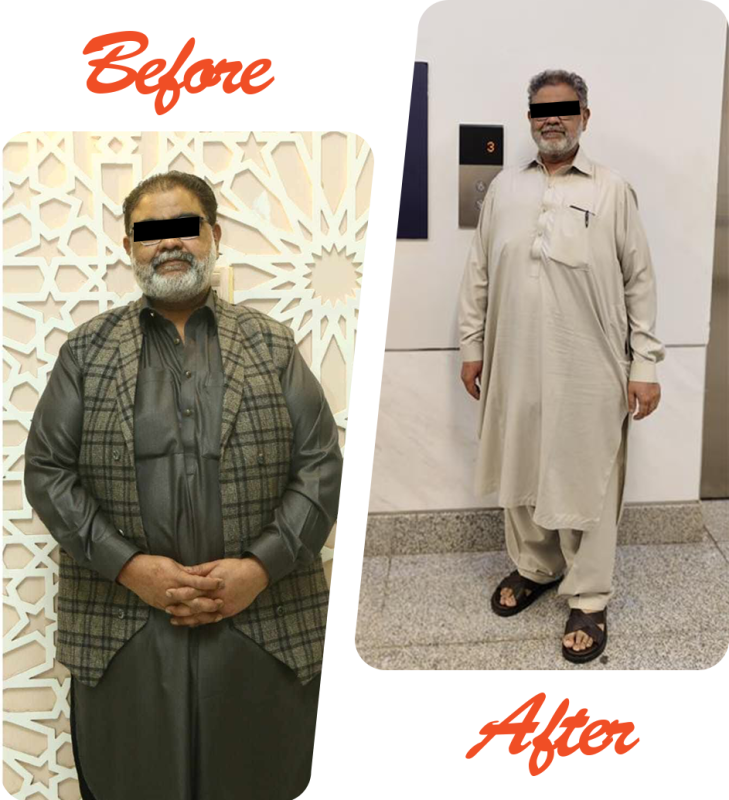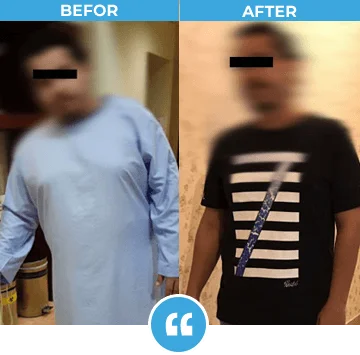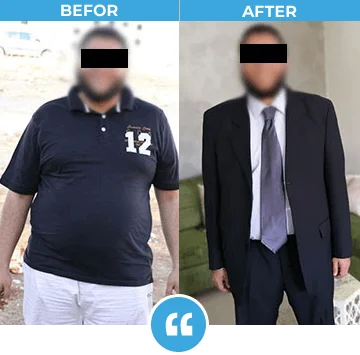SADI Bypass Surgery in Pakistan
Transform Your Body, Boost Your Health – Lasting Weight Loss With SADI Bypass!
Start Your Weight Loss Success Story With Dr. Tahir Yunus, A Renowned Surgeon
- Detailed Pre-Surgery Assessment
- Personalized Surgical Plan
- Advanced Laparoscopic Procedure
- Continuous Medical & Dietary Guidance
- Comprehensive Post-Operative Care
(SADI Bypass Surgery) Single Anastomosis Duodenal-Ileal Bypass
It is a type of weight loss surgery that offers promising results for individuals struggling with obesity. It reduces the size of the stomach, leading to a decreased food intake as it can hold less food around 100-150 ml. Additionally, by creating a connection between the duodenum and the ileum, the surgery bypasses a significant portion of the small intestine, reducing the absorption of calories and nutrients from the food. This alteration also influences the release of hormones that control hunger, satiety, and metabolism, helping to control appetite and promote weight loss.
SADI Surgery Patient Review
The importance of Bypassing the Duodenum
The duodenum is the first part of the small intestine, located just below the stomach. When food leaves the stomach, it enters the duodenum, where several important digestive processes take place.
However, in obese individuals, the duodenum can experience various dysfunctions that contribute to obesity and related health problems. The duodenum plays a role in releasing hormones that regulate hunger and satiety. In obesity, hormonal imbalances can occur, leading to reduced sensitivity to satiety hormones and increased production of hunger-inducing hormones like ghrelin. This can result in overeating and difficulty feeling full, leading to excess calorie intake and weight gain. Insulin resistance can negatively affect the duodenum’s ability to regulate blood sugar levels and may contribute to metabolic disturbances and lead to higher insulin levels. Elevated insulin levels can promote fat storage and hinder fat breakdown, leading to weight gain.
The SADI bypass surgery offers several benefits by partially removing the duodenum. During the procedure, a portion of the duodenum is bypassed, reducing the absorption of calories and nutrients from food. Additionally, hormonal changes occur, helping control appetite and further promoting weight reduction. The surgery has shown positive effects on insulin sensitivity, which benefits blood sugar control, particularly for patients with type 2 diabetes. By preserving some functions of the duodenum while achieving weight loss, the SADI bypass presents a comprehensive approach to managing obesity and related health conditions.
Weight loss with SADI Bypass Surgery
You can lose up to 45% of your total body weight through this procedure. By making lifestyle changes, you can increase it by 5%, and using medicines can add another 10%. In total, you can achieve a 60% reduction in your total body weight with this procedure.
It is highly beneficial for individuals with strong hunger feelings and those who experience frequent and persistent hunger. This procedure is often used for very obese individuals because it offers one of the most aggressive weight loss results provided by bariatric surgery. For example, if a person with a BMI of 50 undergoes the SADI bypass, they can lose up to 20 BMI points and achieve a BMI of 30 or even lower, moving them out of the danger zone of obesity and towards a healthier weight range.
Single Anastomosis Duodenal-Ileal Bypass SADI Bypass Surgery Procedure
During the SADI bypass surgery, the surgeon makes minor cuts in the abdomen. The first step involves creating a sleeve gastrectomy, where a portion of the stomach is removed to make it smaller. Next, the initial segment of the first part of the small intestine (duodenum) is separated from the rest of the duodenum. Then the last 300-350 cm of the small intestine is measured, and the surgeon creates a connection between the duodenum and the last part of the small intestine (ileum). This connection helps bypass a significant part of the small intestine, leading to reduced absorption of calories and nutrients, which ultimately promotes weight loss. After completing the procedure, the incisions are closed. It’s essential for patients to follow post-operative care and make necessary lifestyle changes to support their weight loss journey effectively.
At ALSA Pakistan, Dr. Tahir Yunus performs this procedure with exceptional expertise and unrivaled skillfulness. He strives to help patients achieve significant weight loss and improve their overall health. You can feel confident in his experienced hands, and trust him with your well-being.

Benefits of SADI Bypass Surgery
SADI bypass surgery is a revolutionary weight management technique. It is intended to help people with extreme obesity attain long-lasting benefits. Undoubtedly, it is a more advanced variant of the conventional duodenal switch. It is efficient in terms of its numerous benefits. Patients experience these improvements at different intensities. Yet, some prominent advantages include;
- Significant weight loss
- Reduced risk of acid reflux compared to gastric bypass
- Long-term maintenance of weight loss
- Improved Type 2 Diabetes control
- Improved satiety and appetite control
- Better resolution of obesity-related conditions
Why Choose ALSA Pakistan for SADI Bypass Surgery
It is a proven fact that the weight loss industry is incomplete without the name ALSA Pakistan. We take pride in creating countless success stories regarding weight reduction. Dr Tahir Younas aims to bring about a revolution that can take people away from the disappointment and frustration of being overweight. Here are some highlights that reveal the worth of our proficient surgeon and clinic.
Surgeon’s Credibility
Our weight loss surgeon is an internationally certified specialist. He has performed numerous surgeries in his home country and abroad as well. His extended training and qualifications leave no doubts about his credibility.
International Standards
When exploring the best options for weight loss surgery, Dr. Tahir stands out due to his exposure to international standards. He adopts American surgical protocols as the foundation for practice at our clinic, ensuring excellence in every procedure and optimal outcomes for patients.
Proven Track Record
ALSA Pakistan has been serving for more than a decade. All years of expertise declare it a reliable destination for your weight loss goals.
Patient-Centered Approach
Each patient comes with unique challenges because everyone is born with a unique body. We have a strong belief in this fact, and thus, every single patient receives a personalized treatment plan. That is the reason for very positive feedback from our happy patients.
Patients Success Stories

~Asad

~Ahad

~Murtaza

~Ahmed R

~Usman K

~Fatima S
Clients Reviews

At ALSA Pakistan, I really found everything to be more than I had expected. The credibility of the staff and surgeon, caring behavior, and empathy were all exceptional. I truly believe that it is the best clinic for anyone’s weight loss goals.

Dr Tahir Younas has good communication skills and a strong tendency to help others. His direct guidance, as well as assistance from his staff, removed my fears. I confidently decided to have SADI surgery and achieved my desired goals.

Even after the final decision to have SADI surgery, I was afraid of digestive issues. Thanks to the surgeon for the skillful conduction of the procedure. My body adjusted well, and I experienced numerous health improvements after the operation.

About Dr. Tahir Yunus - Bariatric Surgery Specialist
Dr Tahir Yunus is acknowledged for his proficiency and expertise in weight reduction surgeries. The foundation of ALSA Pakistan was the beginning of the life transformations of obese people. His strong communication skills bring positivity to their patient’s lives. His brief introduction is as follows;
- Education and Certification: He has a strong educational background, starting from graduation from King Edward Medical University Lahore. After that, he moved to the United States of America, where he completed training in general surgery. A certification from the American Board of Surgery expanded his knowledge. He has done fellowship training in advanced laparoscopic, bariatric, and upper gastrointestinal surgery at the University of California San Francisco.
- Experience: Dr Tahir Younas has performed numerous successful surgeries internationally. Saudi Arabia and the United States of America are at the top of the list.
- Achievements: He acquired certification from the American Board of obesity medicine, which was an honor in itself. He remained a consultant surgeon in Saudi Arabia for ten years. Moreover, he was chairman of surgery at the International Medical Center Hospital, Jeddah- Saudi Arabia.
Who Is a Candidate for SADI Bypass Surgery?
Severe Obesity
A body mass index higher than 35 or 40 represents severe obesity. Individuals suffering from severe obesity and related medical issues should consider surgery as a priority.
No severe nutritional deficiencies
Pre-existing nutritional flaws can be a source of the development of medical issues. SADI bypass works to lower nutrient absorption. Thus, patients who are thinking of this operation must not have any underlying severe deficiencies.
Unsuccessful bariatric surgery
SADI gastric bypass surgery polishes the results of bariatric surgery such as sleeve gastrectomy. Thus, individuals dissatisfied with previous surgical results are eligible.
Fertility issues
Women suffering from fertility issues come in the list of
candidates. However, general considerations such as good health status are still valid.
What Should You Expect After a SADI Bypass?
SADI surgery is a big shift and brings numerous changes to your body. Keeping in mind the science of operation, you can experience the following things.
Normally, patients need a hospital stay of 2 to 3 days.
It is crucial to monitor the patient’s health status and to manage mild to moderate discomfort and pain.
Fatigue and diarrhea may also occur in the starting days because the body needs time to adjust to changes.
After settling with modifications made by surgery, patients experience a good metabolic rate.
Overall, a better quality of life due to the prevention of obesity-related diseases.

Recovery Time After SADI Bypass Surgery
The recovery stage is a crucial phase during the weight loss journey. We do not let you feel alone and blank at this critical point. With all the guidance of our surgeon and care, the average recovery period after SADI bypass surgery consists of 6 to 8 weeks. A patient can come back to work in 2 to 4 weeks, depending on the nature of the job or profession. To let the body adjust, moderate activities, exhaustion, and dietary changes are essential in the first few days after operation.
A liquid diet for the first two weeks before progressively switching to soft foods works well. Patients should stick to recommended vitamins, maintain a high-protein diet, and keep themselves hydrated. Moreover, refraining from hard lifting for at least a month can boost the speed of recovery. Visiting your surgeon regularly helps track the development and modification of dietary requirements. Lastly, recommended exercises can be your good companion on the journey as they prevent complications.
Follow-up and Lifestyle Changes
A proper diet plan and appropriate post-operative care are pillars that support recovery and results at the same time. An emphasis on high-protein, low-carb meals is essential to minimize muscle loss. Diet shifts must be gradual and sequential, from clear liquids to blended foods, then soft and eventually solid foods. It is quite easy to avoid dumping syndrome and nausea by skipping overeating and having small, frequent meals. Moreover, one should remain focused on hydration. Regular intake of Iron, B12, calcium, fat-soluble vitamins (A, D, E, and K), and minerals help to cope with the nutritional deficiencies.
While talking about follow-up care, adherence to a surgeon’s prescribed medication matters a lot. Moreover, wound care and following guidance about physical activities is crucial. Plus, it is necessary to gain knowledge of critical conditions that call for consultation with the doctor.
Following are a few drawbacks of
SADI Bypass Surgery;
- Higher risk of vitamin deficiencies, approximately 30%.
- 8% chance of protein malnutrition.
- Increased frequency of gas passage throughout the day.
- Increased number of times to go to the bathroom for passing stool.
However, very rarely these complications are too severe and regular follow-up and proper nutritional management can help minimize risks and ensure a successful outcome.
Frequently Asked Questions
Who is a good candidate for SADI surgery?
People with good general health and no severe deficiency of nutrients come on the list of good candidates. Moreover, age consideration is compulsory. Surgery is recommended for individuals between 18 and 65.
What does the hospital stay for duration?
If everything goes well, the patient needs to stay for a maximum of 3 days. Yet, any complications may extend the duratio
How much weight can I expect to lose?
Overall weight reduction may lie in the range of 60 percent of overall weight. In the beginning 6 months, weight fall is rapid. Through change, take may appear in one year.
What is the diet after SADI surgery?
In the recovery period, starting from liquids, you should gradually shift to solid foods stepwise. In the long run, high-protein meals and low-carb food help to retain results.
Can I regain weight after surgery?
Yes, it is possible to gain weight again. This is often due to poor dietary habits and other lifestyle factors that negatively impact health Consumption of alcohol, sugary foods, smoking, and inactive lifestyle boost the increment.
How long does the SADI procedure take?
The common duration of the operation is 2 to 4 hours. However, if other procedures are required to combine with SADI bypass or for patients with exceptional health issues, time may vary.
How long is the recovery period?
4 to 6 weeks is the most noted period for recovery after a SADI bypass. However, two weeks are enough to get back to your normal activities.
Does SADI help with Diabetes and other conditions?
Yes, SADI surgery provides great results regarding improving Diabetes and other conditions as well. You can experience notable changes in high blood pressure, cholesterol, and other obesity-related issues.
What happens if I overeat after SADI surgery?
Abdominal pain, discomfort, nausea, vomiting, and diarrhea are the common problems you may experience if you eat too much. Slow, small, and mindful eating can be helpful in this regard.

